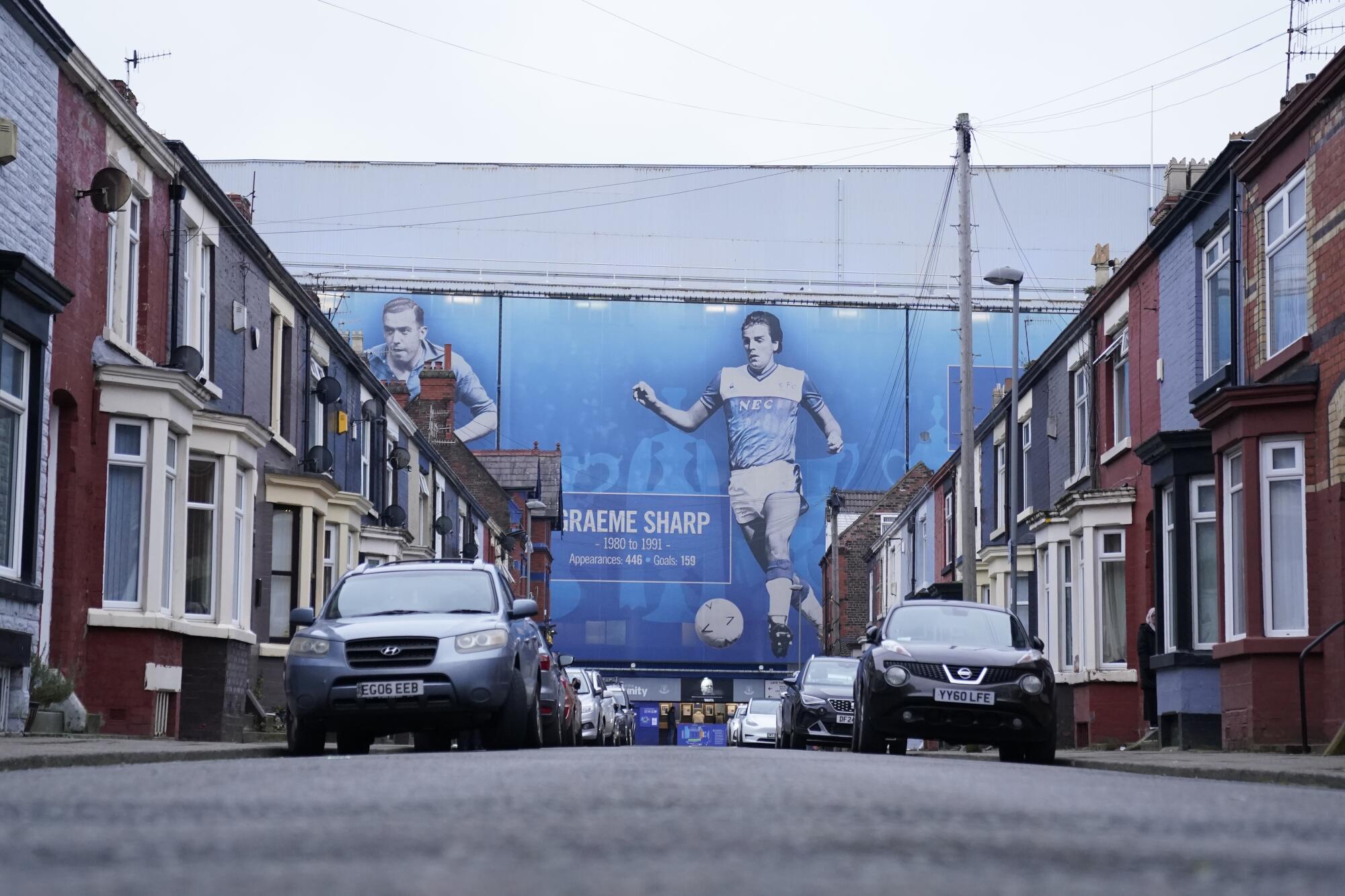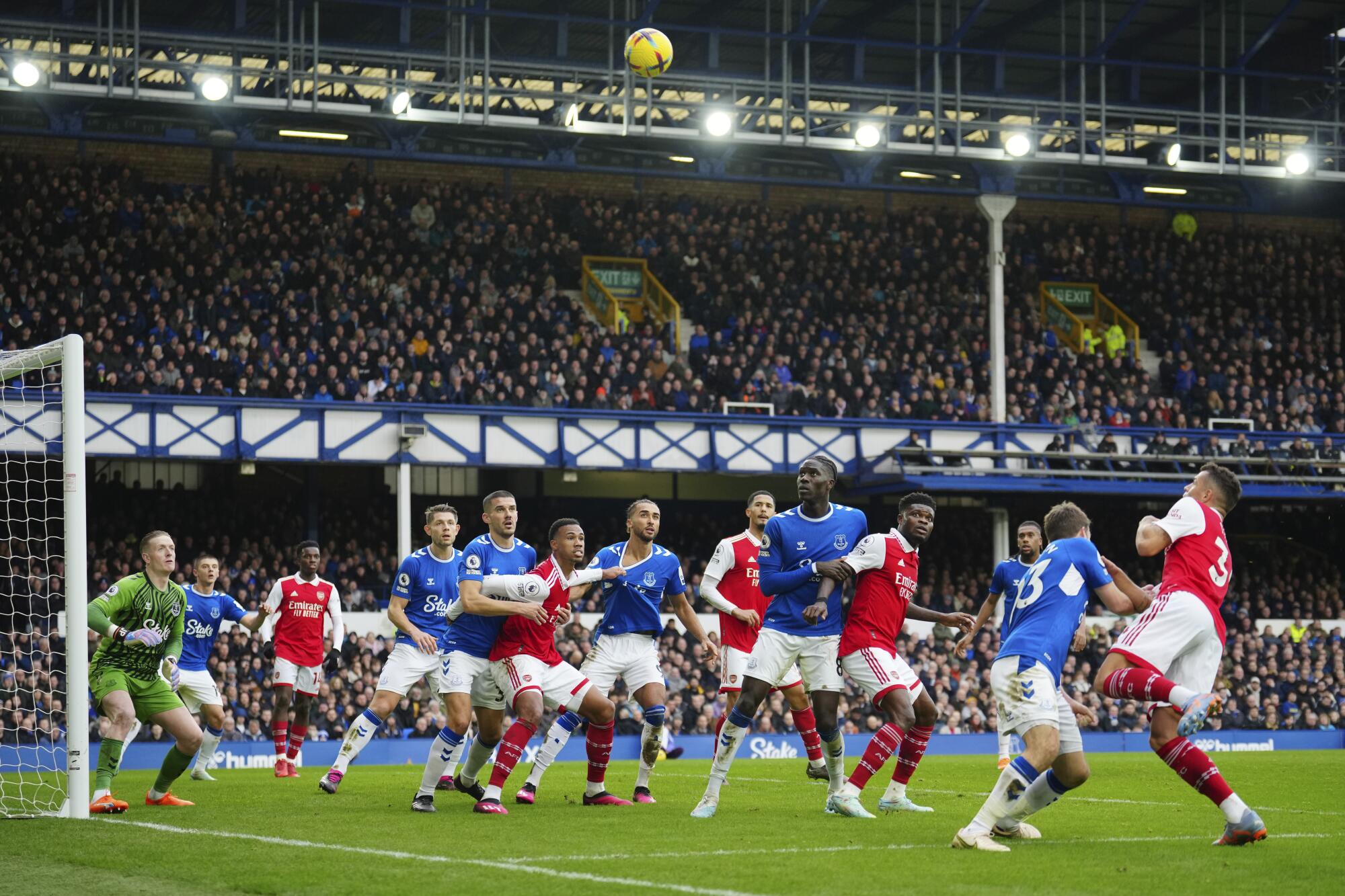
- Share via
How does an iconic team that has had just one home for the past 133 years pack up all that history, culture and tradition when it comes time to move across town?
Very carefully.
Everton FC has been playing at Goodison Park, just north of central Liverpool, since the Victorian Era. And in that time the so-called Grand Old Lady has hosted more top-flight games than any stadium in England.
But Sunday’s match with Southampton will be the last. Next season, the club will play in ultra-modern Everton Stadium, built upon a former dock alongside the River Mersey. And while the move was necessary and probably long overdue, it’s being mourned nonetheless.

“Every stadium move is unique, regardless of what club they are. Especially in English football. There’s history and heritage in every one of those clubs,” said Mo Maghazachi, Everton’s senior liaison and engagement manager. “But specifically to Goodison, Goodison has played a major part in football.”
There is no equivalent in American sports. Fenway Park, the oldest professional sports stadium in the U.S., was built in 1912, two years before Wrigley Park opened.
Goodison was already two decades old by then. And when it opened in 1892, it shared the honor of being the world’s first purpose-built soccer stadium with Celtic Park in Glasgow, which opened the same day.
Not only is it the world’s oldest soccer stadium, it’s the only one with a church on its grounds. (The club does not play early games on Sunday to allow for morning services at St. Luke’s, a 124-year-old Anglican Church enclosed on two sides by the stadium.)

Goodison Park grew over time, becoming England’s first two-tiered stadium in English soccer in 1909. There would be other firsts.
The first flood-lit match in England was played there in 1957, the first underground heating system was installed a year later and the first scoreboard made its debut in 1971. Goodison has been home to so much history, Dan Meis, the Colorado native who designed Staples Center (now Crypto.com Arena), among other sports venues, almost turned down his first meeting with Everton about 10 years ago because he didn’t want to be involved in a project that would replace an intimate, unique stadium with the kind of soulless multipurpose venues then being built in the UK.
“From the very start, [the new stadium] had to be a proper English football ground,” Meis said. “From our perspective, it was don’t focus on the architecture. It’s about the experience.
”So I dove very deeply into the history of English football and that was a driver of the design from the start.”
He wasn’t working alone; Evertonians would never allow that. So when the club conducted a public consultation during the planning phase for the new stadium, 65,000 people took part, making it the largest commercial public consultation ever in Liverpool. And what Meis and the club heard was that the fans wanted something that reflected Everton’s gritty blue-collar pedigree.
“There was a lot of, ‘We’re not fancy, you know, this is about history, and it’s about generations of support throughout,’” Meis said. “It was a sense of history that we had to respect.
“As an American, I was a little bit shy of this, but I talked about their similarities to Fenway or Wrigley, baseball stadiums [that] tended to grow up over time. That’s how those buildings became these kind of quirky, different things like Goodison. You plop down 65,000 seats one time and you lose a lot of that sort of quirkiness. We’re very conscious about that.”

So Everton built its new home on a site that is nearly as historic: the Bramley-Moore Dock. Part of the port of Liverpool in the inner-city district of Vauxhall, the dock opened in 1848 and played a major role in England’s coal trade for nearly 140 years.
“People from Liverpool have a romantic attachment to the docks,” Maghazachi said. “The docks played such an important role in in this city’s history. And it looks like it’s going to play an important role in the city’s future as well.”
The new $989-million stadium, the 12th to enter the Premier League in the last 24 years, was designed to be unique. The stands, for example, are straight rather than curved at the corners. And the 14,000-seat South Stand is the steepest in Europe, placing the fans on top of the action. The Guardian called it “the most striking, ambitious addition to the Liverpool waterfront since … the early 1900s.”
The views are superb, there are no obstructions and there is an impressive panorama of the city’s skyline from the back of the South Stand, the paper added.
But for the club’s most devoted supporters, it’s still going to take some getting used to.
“I felt dirty,” Dave Kelly, the fan-elected chair of the Everton Fan Advisory Board, said of his visit to the new stadium for the first of three test events required for the club to operate at full capacity when the new season begins in August.

“I felt like I betrayed [Everton] football. There was certainly a strange feeling to go there. It felt something that I didn’t particularly have an affinity with.”
Richard Gillham of the Everton FC Heritage Society felt the same way. But those feelings changed when he entered the stadium in February for that test event, a U-18 game between Everton and Wigan Athletic that drew 10,000 specially selected fans.
“I’ve been watching forever; over 50 years now,” said Gillham, who saw his first game at Goodison in 1972. “And I would never, ever want us to move. Until I went to the first test event.
“The new stadium is absolutely awesome. It’s ready for European and international football.”
And Goodison, for all its history and charm, is not — because the stadium, like most things that are 133 years old, has not aged well.
It’s capacity, which peaked at nearly 80,000 just after World War II, is about half that today. Many seats, located behind thick steel girders, have obstructed views and the stadium can feel dark and dank on cold Liverpool nights.
More significantly, Goodison Park, with just 12 corporate suites, was limited in its ability to generate both match-day and commercial revenue. That has made it difficult for the team to compete in the most expensive soccer league in the world.
Two years ago, Everton took four points from its final two games to narrowly avoid relegation for the first time in 69 years. The Toffees haven’t finished in the top half of the 20-team EPL table since 2019 and haven’t played in a European competition in a decade.

The new stadium not only has a capacity of 52,888 — about 13,000 more than Goodison, making it the seventh-largest in the Premier League — it has as many as 100 suites and other VIP hospitality options as well. Those packages, the club said, are already sold out.
But what can’t be moved from Goodison Park to the banks of the Mersey is the community Everton has built in the Blue Mile, the neighborhood that surrounds the old stadium like a warm hug. The 10,000 residents of that area are among the poorest in England and the club has risen to meet that need with a paid and volunteer staff of more than 300 that administers more than four dozen club-funded programs addressing issues including education, dementia, poverty, health, substance abuse and employability. Everton runs its own school and community center.
The team said none of that work will be affected by the team’s move across town. Goodison Park may even be spared the wrecking ball. Although the stadium was scheduled to be torn down and replaced by a housing complex, a community health and medical center, an education center and a park, among other things, the Friedkin Group, the team’s new American owner, recently commissioned a feasibility study to determine if the venue could be preserved for use by Everton’s academy and women’s teams.
In the meantime, Everton will play three games in the U.S. before its first Premier League match in its new stadium, facing Bournemouth at New Jersey’s MetLife Stadium on July 26, West Ham on July 30 at Chicago’s Soldier Field, and Manchester United on Aug. 3 at Mercedes-Benz Stadium in Atlanta. Whom the Toffees face in their first competitive match in the new stadium won’t be announced until June 18.
Yet even after the new stadium opens, Maghazachi said the Blue Mile will remain the team’s home. Because while you can move the players, 133 years of history in one spot tends to leave deep roots.
“We’ve never talked about Everton leaving Goodison Park, or leaving Liverpool L4 as the area is called,” he said. “We talked about the playing side leaving and the men’s football team leaving and heading to the Bramley-Moore Dock to play.
“But the football club isn’t leaving. It’ll always be our home.”
⚽ You have read the latest installment of On Soccer with Kevin Baxter. The weekly column takes you behind the scenes and shines a spotlight on unique stories. Listen to Baxter on this week’s episode of the “Corner of the Galaxy” podcast.




